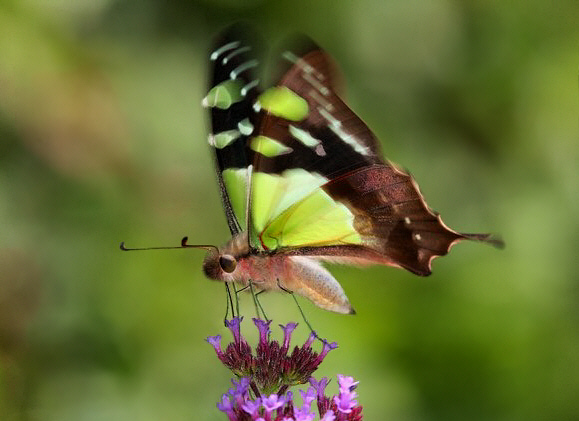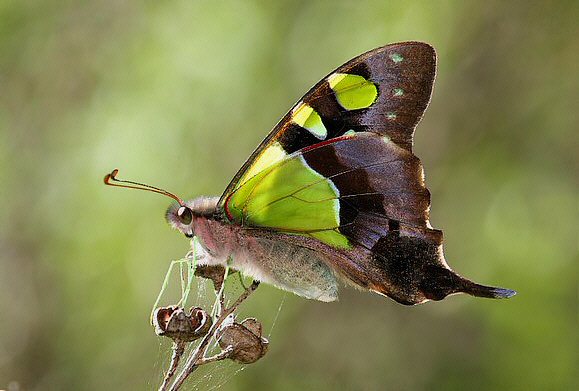
Introduction
The genus Graphium is widespread in the Old World, with 35 species in the Afrotropical region, 14 in the Oriental region, 6 in the Holarctic ( south & west China ) and 20 in the Australian region.
Most of the Oriental and Australasian species are characterised by the presence of a pattern of translucent green, turquoise or yellowish “windows” in their wings. There are a few however such as aristeus from New Guinea and the Oriental species euphrates which are predominantly white, marked with vertical black stripes. Arguably the most beautiful and unusual of all is weiskei from Papua, a tailed species patterned with vivid pink and green on a dark brown ground colour.
Graphium macleayanus is endemic to eastern Australia, being found from Queensland to Tasmania.
Habitats
This species is found in forest edge habitats including rainforest clearings and glades, deciduous woodland, parks and gardens. In tropical Queensland it is primarily a mountain butterfly, but in New South Wales and Tasmania it can be found commonly down to sea level.

Lifecycle
The pale green, globular eggs are laid singly on leaves and young shoots of the larval foodplants, which include Doryphora and Atherosperma ( Atherospermataceae ), Cinnamomum ( Lauraceae ), Geijera ( Rutaceae ), and Drimys ( Winteraceae ).
The fully grown caterpillar is pale green with faint whitish spots. It is humped at the thorax, which carries a pair of short tubercules at the widest point. The body tapers towards the head and tail. As with all Papilioninae, there is an extrusible soft fleshy orange-coloured organ behind the head, which emits foul-smelling odours as a means of defence against predators and parasitoids.
Adult behaviour
Males commonly imbibe mineralised moisture from bare ground, especially in stony or rocky areas. Females seem to be much scarcer than males, and are usually only encountered when they nectar at the flowers of trees, bushes or herbaceous plants.
Sometimes on hot mornings large numbers of males, and much lower numbers of females, can be found “hill-topping”, i.e. gathering at what is effectively a lek, on a hilltop or mountain ridge. This behaviour is common among the Papilionidae and other butterfly families. It enables low density forest-dwelling species which would otherwise have difficulty in locating mates, to home in on a meeting place.
At these hill-topping sites, males set up individual territories which they defend against all comers, including bees, flies and other butterfly species. Aerial combats between rival males are aggressive but usually short-lived, with the original “owner” of the territory generally successfully driving off the intruder. When an already-mated female is intercepted by a male, she drops instantly to the ground, opens her wings and raises her abdomen to indicate that she is unavailable for copulation, at which point the male quickly loses interest. If a virgin females is intercepted, she is chased by the male, rising and falling as she flies, with the male mirroring her every movement, until they disappear from view, presumably to copulate.
